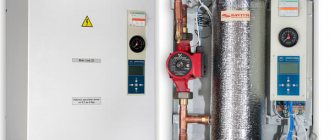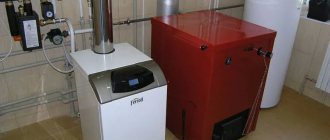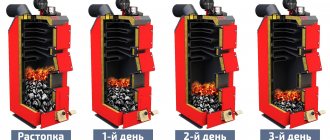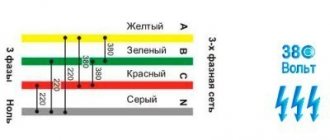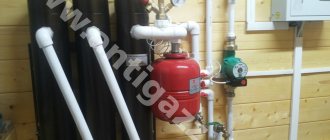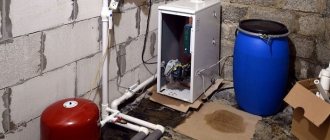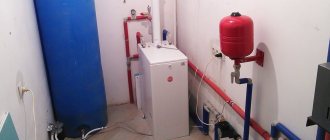First of all, when organizing heating for a private home, you need to decide on the type of fuel used. This is the main criterion for choosing a boiler, on which further operating costs, autonomy and stability of the heating system depend.
Having decided on the type of fuel, you need to select the minimum required power, pay attention to the number of circuits, installation method, heat exchanger materials, method of air intake and exhaust of combustion products. Let's consider the entire process of choosing a boiler for a house with an area of 100 m2 one by one.
Gas, solid fuel, liquid fuel or electric
For domestic use, 4 sources of thermal energy (4 types of fuel) are used:
- Gas. Gas boilers are the most widespread, accounting for more than 60% of demand. Using natural gas as fuel is one of the most profitable options. The gas has high heat transfer, when burned it produces a minimal amount of toxic combustion products, and its storage does not require large areas and tanks. At the same time, gas boilers are distinguished by affordable prices (the best models in the middle price segment range from 19-28 thousand rubles), have high efficiency (on average 88-94%), the most developed and functional automation, and work for weeks without human intervention. In general, the gas boiler industry is the most developed and competitive: for the buyer this means the availability of increasingly affordable, high-quality, economical models, as well as a developed service structure (both in Moscow and St. Petersburg, and in the regions).
- Solid fuel (wood, coal, pellets). Solid fuel boilers occupy about 7-15% of the market and are still widely used in places where there is no gas mains or regions with access to solid fuel for a nominal price. The disadvantages of solid fuel boilers are known to everyone - this is the unstable release of thermal energy, the need to procure fuel, organize a place for its storage, constant kindling and cleaning of the boiler unit. To maintain the combustion of wood-burning boilers, human intervention is required on average every 2-4 hours, for coal boilers - 5-10 hours, depending on the type of coal. However, there are also more autonomous and more comfortable to use long-burning models, and there are also pellet boilers with fully automated fuel supply.
- Liquid fuel (diesel, waste oil, fuel oil, kerosene). Diesel boilers and boiler units operating in exhaust gases occupy about 10% of the market and are universal. Liquid fuel boilers are installed exclusively in a separate room under the boiler room, require a fuel storage tank (in the boiler room or outside the house), but at the same time they have high efficiency, are able to work completely autonomously, produce a minimum of toxic emissions when burned, and the cost of fuel is often significantly lower than gas . The most affordable and profitable models are the diesel Navien and Kiturami, which differ from their gas counterparts only in the burner design.
- Electricity . Electric boilers are almost ideal in terms of operating comfort and functionality, however, the cost of electricity is the highest for full heating of a house of 100 square meters. m. can cost from 7 to 10 thousand rubles. per month. It is most rational to use an electric boiler when temporarily living in a house, then the low cost of the boiler and heating system will pay off operating costs for a long time. There are also options for using it in tandem with a buffer tank that accumulates the heat generated by the boiler at a reduced night rate, or using it as a backup boiler unit.
Efficiency and selection criteria for energy-saving electric heating boilers
To summarize, if there is a gas main near the house, we recommend choosing a gas boiler without hesitation. If there is no gas main, you should choose based on personal preferences for the method of maintaining combustion, the availability of fuel in the region, requirements for autonomy, the cost of the boiler and its installation.
Heating system safety
Modern gas heating boilers are equipped with sensors that monitor operation at all stages - from gas and water supply to exhaust gases.
Wall-mounted boilers are equipped with sensors that block the heating system in the event of a power outage. When the temperature rises above the set norm, the boiler is blocked. For normal operation of such a system, a constant supply of electricity is required, since these systems are connected to the network.
Floor-standing gas installations are equipped with sensors that operate in mechanical mode, regardless of the presence of electricity. Control over the work process occurs at all levels, from gas supply to the removal of exhaust gases from the system.
In double-circuit boilers there is a risk of scale formation. To eliminate this problem, water filters are installed, which soften the water supplied to the heater and significantly reduce the risk of scale formation.
The minimum required boiler power for a house is 100 sq. m.
Power requirements depend on the heat loss of the house, the boiler simply must replenish them. For an average house in the climatic zone of the Moscow region with a masonry of 2 bricks and a ceiling height of 2.7 m, the heating capacity is calculated according to the rule: 1 kW of power for every 10 m2 of heated area. We also recommend a power reserve of 10-30%, depending on the type of fuel used.
For example, the minimum required boiler power for a house with an area of 100 square meters. m. = 10 kW * 1.2 = 12 kW.
Often manufacturers do not produce 12 kW versions, limiting themselves to 10 and 15 kW boilers, so you can choose a 14 or 15 kW model, but no more. A boiler unit of too high power will cycle more frequently (on/off), which reduces its service life.
Standard simplified calculations are sufficient for more than 95% of cases. If the house is well insulated, is located in the extreme southern or northern point of the country, has high ceilings or a large glazing area, more accurate calculations are made. You can do this using the calculator below.
Calculator for accurate calculations
The heating boiler must provide the total power of the radiators (boiler power ≥ total power of the radiators), so first you need to use a calculator to calculate the power of the radiators for each room separately. By summing up all the obtained values, you will get the minimum required boiler power.
General points
In order for the house to be warm, the heating system must replenish all existing heat losses in full. Heat escapes through walls, windows, floors, and roofs. That is, when calculating the boiler power, it is necessary to take into account the degree of insulation of all these parts of the apartment or house. With a serious approach, they order a calculation of the building’s heat loss from specialists, and based on the results, they select the boiler and all other parameters of the heating system. This task is not to say that it is very difficult, but it is necessary to take into account what the walls, floor, ceiling are made of, their thickness and the degree of insulation. They also take into account the cost of windows and doors, whether there is a supply ventilation system and what its performance is. In general, a long process.
There is a second way to determine heat loss. You can actually determine the amount of heat that a house/room loses using a thermal imager. This is a small device that displays the actual picture of heat loss on the screen. At the same time, you can see where the outflow of heat is greater and take measures to eliminate leaks.
Determining actual heat loss - an easier way
Now let’s talk about whether it’s worth taking a boiler with a power reserve. In general, constant operation of equipment at the limit of its capabilities negatively affects its service life. Therefore, it is advisable to have a performance reserve. Small, about 15-20% of the calculated value. It is quite enough to ensure that the equipment does not work at the limit of its capabilities.
Too much stock is not economically profitable: the more powerful the equipment, the more expensive it is. Moreover, the price difference is significant. So, if you are not considering the possibility of increasing the heated area, you should not take a boiler with a large power reserve.
How to choose a boiler for heating a private house
Floor or wall
Gas wall-mounted Vaillant with the necessary elements and components of the heating system built into the body.
Floor-standing models are more resourceful and versatile, most of them are non-volatile, i.e. not requiring connection to the electrical network (with the exception of electric boilers). Wall-mounted models are more compact, and from the factory they already contain an expansion tank, a circulation pump, a safety valve, an air vent and other elements of the heating system.
Wall-mounted models are equipped with lightweight steel or copper heat exchangers, which, even despite special coatings, are susceptible to corrosion and last no more than 12-16 years. Floor-standing models are not limited in weight, so heavy cast iron heat exchangers with thick walls are often installed in them; cast iron is practically not subject to corrosion, and the service life of such heat exchangers is more than 25-30 years.
Please note that solid fuel and liquid fuel models are presented only as floor-standing models due to technical features.
Single-circuit or double-circuit
A visual principle of operation of double-circuit boilers with priority for hot water supply (DHW).
Single-circuit boilers are intended exclusively for heating. Double-circuit models are equipped with an additional heat exchanger, with the help of which sanitary water is also heated for hot water supply at home. Sanitary water from the DHW circuit does not mix with technical water from the heating circuit.
The cost of double-circuit boilers is only 10-20% more expensive than single-circuit versions, so this is the most profitable way to solve the issue of hot water supply.
Heat exchanger material
The heat exchanger that transfers the thermal energy of combustion to the coolant can be made of:
- steel is the lightest and most inexpensive option to produce, used primarily in wall-mounted models and boilers in the low and mid-price segment. Steel heat exchangers have thin walls and are susceptible to corrosion, so their resource is limited by physical properties, service life is 12-14 years;
- Copper is a more corrosion-resistant, more thermally conductive, but also more expensive metal. Copper heat exchangers are used in models of the middle and high price segments, their service life is about 13-17 years;
- cast iron - resistant to corrosion, retains heat for a long time, but is heavy and fragile. The service life of cast iron heat exchangers is at least 25-30 years.
How to choose a room thermostat and save up to 30% per month on heating
Combustion chamber design and types of smoke removal
There are several options for organizing fuel combustion:
- an open combustion chamber and natural draft through a vertical chimney is a standard option used in floor-standing models, when air for fuel combustion is taken from the room, and combustion products are naturally discharged into a vertical chimney. For fuel combustion, proper ventilation must be provided in the boiler room;
- a closed combustion chamber and forced draft through a coaxial chimney is a simpler option to organize; it is used in wall-mounted and some floor-standing models. Air intake and combustion products removal are carried out through a compact coaxial (side) chimney. The chimney itself comes complete with the boiler.
Electric boilers do not require air intake and exhaust of combustion products, and therefore no chimney.
Types of gas burners by flame regulation
The criterion applies exclusively to gas boilers, the burners of which can be of 3 types:
- single-stage – works in on/off mode;
- two-stage - operates in off, 50 and 100% power modes. This reduces the load and increases fuel economy;
- modulated – smoothly regulates power within 10-100%. This is the best, but also more expensive type of burner, since the boiler automation can achieve the most economical and gentle mode of operation of the burner - continuous burning at the lowest possible power.
Efficiency
Efficiency factor (efficiency) is the ratio of the volume of fuel consumed by the boiler to the volume of heat generated, i.e. efficiency. Average normal values:
- for gas - 88-94%;
- for solid fuels – 82-89%;
- for liquid fuels – 86-91%;
- for electric ones – 99%.
Accordingly, the lower the efficiency, the less thermal energy is accumulated by the coolant. If for liquid fuel boilers during testing this is an insignificant indicator due to the symbolic cost of fuel, then for gas boilers every additional % efficiency contributes to tangible savings.
Additional criteria
Having decided on the main selection criteria one by one, you can turn to additional ones:
- condensation of combustion products – used in long-burning gas and solid fuel boilers, when an additional heat exchanger accumulates the remaining heat of combustion products. Thus, a significant part of the heat does not “fly down the drain”;
- automation functionality - modern models can be equipped with a programmer that allows you to set the boiler operating mode for the next day or week, for example, by setting the temperature to 15°C during working hours when the owners are not at home, which will significantly reduce fuel consumption. Also important is the ability to connect a room thermostat, the presence of protection against overheating and stopping the circulation pump, and a frost prevention mode. Solid fuel boilers, as a rule, are not equipped with functional automation;
- the presence of heat and sound insulation - a layer of thermal insulation reduces heat loss through the boiler itself, and sound insulation used in gas, diesel and electric models makes their operation almost silent.
Modulation is not a perfect solution.
A boiler with a modulating burner produces energy equal to the current heat demand. At first glance, one might assume that when choosing such a boiler there is no need to accurately determine the heat loss of the house. After all, knowing them only approximately, you can buy a boiler of greater power, which in any case will work with the power required at a certain moment. Unfortunately, in practice, boiler power modulation does not completely solve all issues. Immediately after switching on, the boiler begins to operate at maximum power; after some time, its automation begins to reduce power to the optimal level. If a powerful boiler operates in a small system, then in conditions where the heat demand is small (i.e., the outside temperature is around zero or above), the water in the system will heat up even before the burner reaches the required modulation level and the boiler turns off. The water in the system will quickly cool down and the situation will repeat. The boiler will operate in pulse mode - as if it were equipped with a single-stage high-power burner. Power modulation is only possible within a limited range, which is usually no less than 30% of the maximum power. Therefore, too high a maximum boiler output will lead to difficulties in adapting its performance at higher outside temperatures. There are boilers with a wider power modulation range, but these are more expensive condensing boilers.
The best known manufacturers and models: characteristics and prices
BAXI ECO Four 1.14 F
One of the best boilers for heating a private house with an area of 100 m2. The Italian gas wall-mounted single-circuit boiler with a power of 14 kW is known for its high reliability and efficiency - efficiency of 92.5% with a maximum gas consumption of 1.6 cubic meters. m/hour. It also features a copper heat exchanger, virtually silent operation and functional automation with the ability to connect a room thermostat. During the installation practice, no serious deficiencies were identified; according to reviews from the owners, the model has been working without problems for more than 7 years.
Baxi SLIM 1.150i 3E
Floor-standing double-circuit Italian model with a power of 14.9 kW. It is distinguished by the presence of a cast iron heat exchanger, functional and reliable automation, the presence of a circulation pump and a modulated burner. The boiler efficiency is 90.3% with a maximum gas flow of 1.74 m3/hour. The only disadvantages are heavy weight, vulnerability to voltage surges (connection via a stabilizer is recommended) and high price.
Buderus Logamax U072-12K
One of the most affordable reference German models with a capacity of 12 kW (heating and hot water supply). Characterized by good efficiency - efficiency of 92% at a maximum flow rate of 2.1 m3/hour, convenient and functional controls, aesthetic design and compact dimensions. The main advantage over analogues is the price.
However, there are also disadvantages in the form of an insufficiently strong plastic make-up tap and vulnerability to voltage surges. The main advantage over analogues is the price.
Teplodar Cooper Praktik 14
A common budget solid fuel boiler made in Russia with a capacity of 14 kW. It is distinguished by a simple and reliable device, a block of heating elements (6 kW) pre-installed from the factory, which are capable of maintaining an acceptable coolant temperature for a long time, for example at night, after the firewood has burned out. You can also use coal and peat briquettes as fuel.
It has disadvantages typical for the budget price segment: a steel heat exchanger, a small combustion chamber, and is picky about the size of firewood.
Combined electric gas boilers: their efficiency, best models and prices
Stropuva S15U
Lithuanian solid fuel boiler with long burning, power 15 kW is more than enough for a house of 100 sq. m. Mine-type model (air supply from above), which, when heating with coal, ensures the burning duration of one bookmark up to 7 days. The boiler efficiency is 85%, which is optimal for a solid fuel model. According to installation practice and owner reviews, no serious malfunctions have been noticed for more than 6 years.
When burning with wood, it has significant disadvantages: high requirements for dry wood and a high level of tar formation on the walls of the firebox. The manufacturer recommends using coal as fuel.
Cost: 99-100 thousand rubles.
Poll: what type of boiler did you choose?
Helpful advice
Heating diagram in the apartment.
When choosing a boiler for a country house that has a natural gas pipeline, you should not listen to gas service workers. Sometimes they convincingly encourage you to buy boilers from a particular manufacturer, and when people come to the store, they begin to demand a specific boiler. It seems that gas workers are not bad, because gas workers recommend a boiler that is already familiar to them, but on the other hand, they simply advertise the manufacturer and maybe receive an additional salary for this. It happens that they insist and declare that if you choose a gas boiler from another manufacturer, there will be no service.
In order to choose the right one and subsequently purchase a good quality gas boiler, you need to ask friends or ask salespeople in the store, who will select the best option for a country house or dacha.
Prices: summary table
| Model name | power, kWt | Efficiency, % | Gas consumption, m3/h. | price, rub. |
| BAXI ECO Four 1.14 F | 14 | 92,5 | 1,6 | 47 000 |
| Baxi SLIM 1.150i 3E | 14,9 | 90,3 | 1,74 | 83 000 |
| Buderus Logamax U072-12K | 12 | 92 | 2,1 | 41 000 |
| Teplodar Cooper Praktik 14 | 14 | — | — | 20 000 |
| Stropuva S15U | 15 | 85 | — | 99 000 |
What other heat losses need to be taken into account?
Even taking into account the climate zone cannot give a complete picture of the heat loss of a private home. Some have double plastic windows installed, while others haven’t bothered to replace the old wooden frames, while others have insulated the outer walls. and for some, the street and the room are separated by only one layer of brick.
According to average data based on expert calculations, the largest heat losses occur on uninsulated walls and amount to about 35%. A little less, 25% of the heat, is lost due to a poorly insulated roof. Ideally, there should be a warm attic above the house. Poor floor insulation can absorb up to 15% of the heat generated by the boiler, just like old wooden windows. We must also not forget about ventilation and open windows, which account for 10 to 15% of heat loss.
Thus, it turns out that the generally accepted formula is not suitable for every residential building. For such cases, there are different counting systems.
How to calculate how much heat is needed to heat water?
To calculate the thermal power, you must independently add the heat consumption for hot water supply to the previous indicator. To calculate it, you can use the following formula:
Qв = с × m × Δt
- c
is the specific heat capacity of water, which is always equal to 4200 J/kg K, - m
– mass of water in kg - Δt
– difference in temperature of heated water and incoming water from the water supply.
For example, the average family consumes 150 liters of warm water. The coolant that heats the boiler has a temperature of 80 °C, and the temperature of the water coming from the water supply is 10 °C, then Δt = 80 - 10 = 70 °C.
Hence:
Qв = 4200 × 150 × 70 = 44,100,000 J or 12.25 kW/h
Then you need to do the following:
- Let's say you need to heat 150 liters of water at a time, which means the capacity of the indirect heat exchanger is 150 liters, therefore, 12.25 kW/h must be added to 28.58 kW/h. This is done because the Qzag indicator is less than 40.83, therefore, the room will be cooler than the expected 20 ° C.
- If the water is heated in batches, that is, the capacity of the indirect heat exchanger is 50 liters, the figure of 12.25 must be divided by 3 and then added independently to 28.58. After these calculations, Qzag is equal to 32.67 kW/h. The resulting indicator is the power of the boiler, which is necessary to heat the room.

